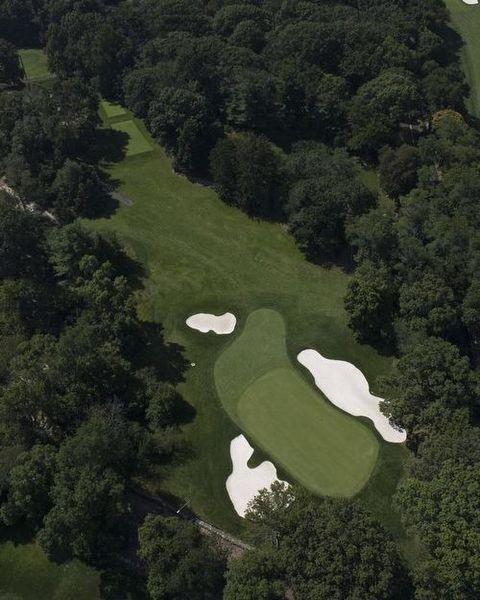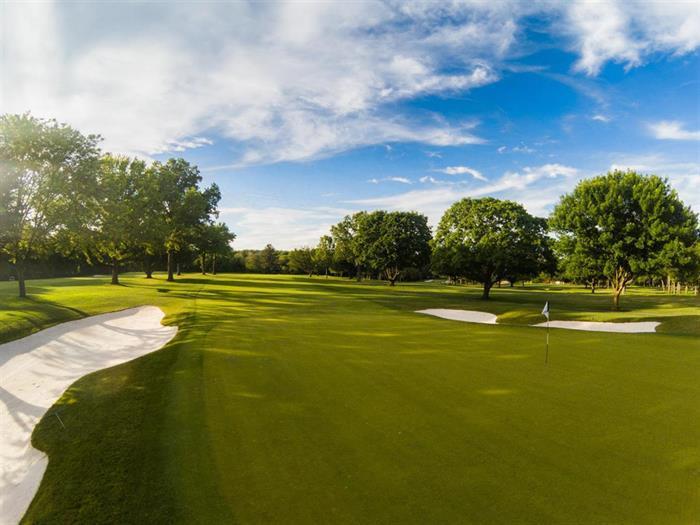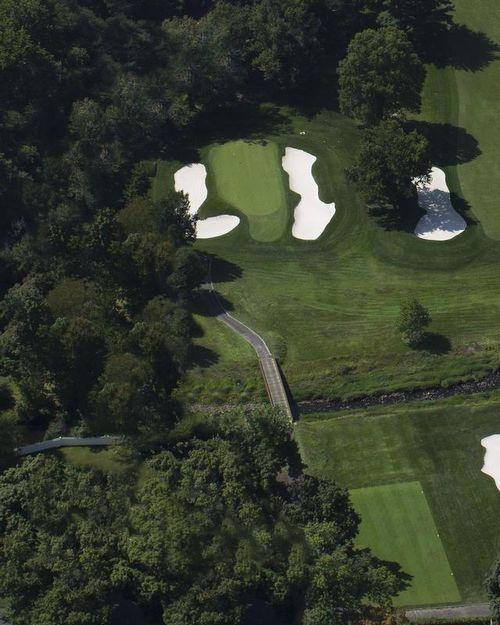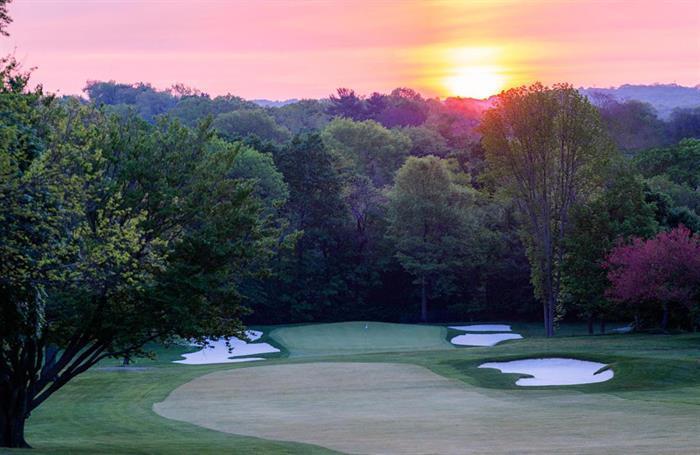Tour the Course

Hole # 1 - A.W.
Number Many classic old courses start with a “gentle handshake,” a hole that eases the player into the round. Not so at Brooklawn. A.W. Tillinghast created a demanding 435-yard par four opener, a dogleg left around a large bunker that is a 250-yard carry from the back tee. Facing a classic risk/reward hole, the player who carries the bunker has less than 160 yards home, while the player who plays out to the right might have more than 200 yards to an elevated green flanked by four deep bunkers. In addition, a false front will repel any shot that is not struck solidly into the middle of the green.
| Tee Information | ||||||||
|---|---|---|---|---|---|---|---|---|
| Black | Blue | Green | Blue Ladies | Green Ladies | Red Ladies | Yellow | Par (Men/Ladies) | Handicap (Men/Ladies) |
| 435 | 420 | 410 | 420 | 410 | 397 | 320 | 4/5 | 5/5 |

Hole # 2 - Knight
The golfer, relieved at having navigated the first, promptly encounters the second of Brooklawn’s strong opening holes at this 210-yard par three. The green itself is relatively flat by Tillinghast standards and is one of the largest on the course. But another example of Tillinghast’s defensive tactics is encountered for the first time at number two: a green that runs slightly front to back, making distance control paramount to keep the ball from running through the green. A cross bunker is well short of the green and will catch any poorly struck shots.
| Tee Information | ||||||||
|---|---|---|---|---|---|---|---|---|
| Black | Blue | Green | Blue Ladies | Green Ladies | Red Ladies | Yellow | Par (Men/Ladies) | Handicap (Men/Ladies) |
| 210 | 195 | 160 | 195 | 160 | 160 | 143 | 3/3 | 17/15 |

Hole # 3 - Westward Ho!
At 379 yards, number three is a par four that—with the narrow green sitting well above the level of the fairway—should be receiving well-lofted high irons onto its sharply contoured surface. But the emphasis is on accuracy at three: out of bounds runs the length of the left side and golfers too far right will be coming out of rough and contending with a deep bunker that guards the flank of the fairway. Deep, sand-filled craters guard both left and right sides of the green. The green itself slopes from back to front. This par four is made more difficult because second shots will be struck off a sidehill upslope.
| Tee Information | ||||||||
|---|---|---|---|---|---|---|---|---|
| Black | Blue | Green | Blue Ladies | Green Ladies | Red Ladies | Yellow | Par (Men/Ladies) | Handicap (Men/Ladies) |
| 379 | 366 | 340 | 366 | 340 | 270 | 270 | 4/4 | 13/13 |

Hole # 4 - Squire
The par four fourth confronts the golfer with many challenges. At 469 yards, it has length. On the left lurks out of bounds. On the right, trees and dense rough. Bunkers guard the green left and right. Behind the green, a steep slope plunges away to a spot 10 feet below the putting surface. From the tee, the landing area is blind, as the fairway begins a gentle downslope 220 yards from the tee and continues its gradual descent all the way to a very severe green with a large ridge on the left side. The left-sloping fairway kicks balls landing short of the green toward a large fronting bunker, making not only distance but direction key to the second shot.
| Tee Information | ||||||||
|---|---|---|---|---|---|---|---|---|
| Black | Blue | Green | Blue Ladies | Green Ladies | Red Ladies | Yellow | Par (Men/Ladies) | Handicap (Men/Ladies) |
| 469 | 440 | 420 | 440 | 420 | 406 | 372 | 4/5 | 3/11 |

Hole # 5 - Bishop
From a strenuous four-par, the mood at five shifts dramatically to a downhill par three measuring 195 yards on the card, but playing somewhat shorter. Club selection is the ticket to the fifth green. That selection – correctly made and followed by solid contact – should position the golfer for a reasonable birdie attempt. Although flanked by bunkers, the green is not as elevated as many at Brooklawn – except in the back, where a steep bank falls off to a large, deep bunker and a blind escape shot.
| Tee Information | ||||||||
|---|---|---|---|---|---|---|---|---|
| Black | Blue | Green | Blue Ladies | Green Ladies | Red Ladies | Yellow | Par (Men/Ladies) | Handicap (Men/Ladies) |
| 195 | 173 | 147 | 173 | 147 | 130 | 125 | 3/3 | 15/17 |

Hole # 6 - Elbow
The tee shot at the par four sixth plays uphill and needs to be thoughtfully positioned, as the hole swings gradually but increasingly to the left before culminating at a narrow, sloping and very tightly bunkered green. Drives left or right are treated with equal disdain, as trees await on both sides. Any second shot plays to a green that is slightly uphill from the fairway and a putting surface that has a severe back-to-front slope. The entrance pinched by a bunker front left and a large one running the length of the green on the right. A third bunker menaces to the left rear. Historically, some of Brooklawn’s better golfers intentionally left their second shot short of the green and depended on a chip to save par—just to avoid those bunkers.
| Tee Information | ||||||||
|---|---|---|---|---|---|---|---|---|
| Black | Blue | Green | Blue Ladies | Green Ladies | Red Ladies | Yellow | Par (Men/Ladies) | Handicap (Men/Ladies) |
| 401 | 380 | 347 | 380 | 347 | 305 | 305 | 4/4 | 7/9 |

Hole # 7 - Wheeler
Not until the seventh does the golfer encounter a five-par at Brooklawn, and this one is a big, rambling affair that offers a bit of everything: dogleg, sand, water, side hill/downhill lies and it’s got 610 yards of real estate on which to present all of its topography. The layout: dogleg right around a stand of trees with a corner that is 300 yards from the tee. Then the fairway begins a long march downward to flatlands. The Rooster River cuts a straight path across the fairway at the bottom, and finally there is the green – smallish and rather sand-bound, demanding precise aim and distance control to give the player a birdie putt.
| Tee Information | ||||||||
|---|---|---|---|---|---|---|---|---|
| Black | Blue | Green | Blue Ladies | Green Ladies | Red Ladies | Yellow | Par (Men/Ladies) | Handicap (Men/Ladies) |
| 610 | 588 | 510 | 588 | 510 | 490 | 425 | 5/5 | 1/1 |

Hole # 8 - Cornell
After the length of seven, at the 493-yard par five eighth the golfer is beguiled by an innocent looking hole. An avian paradise if ever there was one! The only question is which type: eagle? Surely, birdie. Not so fast. Some will walk away not quite sure why they didn’t score better. The tee shot plays into a sharp upslope which limits distance. The golfer who elects to go for the green with his blind second shot takes the risk of getting beyond the hole or to the right of a tiny, elevated green ringed by deep bunkers, which is extremely slick from back to front and right to left. It’s important to leave your ball below the hole on eight, but the false front sends balls struck too delicately back down into the fairway. Players who are out of position left or right are largely left to guessing how their ball will react on the green.
| Tee Information | ||||||||
|---|---|---|---|---|---|---|---|---|
| Black | Blue | Green | Blue Ladies | Green Ladies | Red Ladies | Yellow | Par (Men/Ladies) | Handicap (Men/Ladies) |
| 493 | 448 | 394 | 448 | 394 | 361 | 307 | 5/5 | 9/3 |

Hole # 9 - Brook
The downhill, 396-yard ninth will yield its share of birdies – and extract its share of bogies. Players should finesse the ball slightly to the left side from a tee situated well above the fairway, which is 30 yards wide in the landing zone and guarded by a bunker on the right side and trees on the left. From there it will be a high iron across the Rooster River to a dime-sized, sloping green that is flanked by bunkers. Being one of the smallest greens on the course, the ninth often leaves golfers missing the putting surface short-sided.
| Tee Information | ||||||||
|---|---|---|---|---|---|---|---|---|
| Black | Blue | Green | Blue Ladies | Green Ladies | Red Ladies | Yellow | Par (Men/Ladies) | Handicap (Men/Ladies) |
| 396 | 361 | 345 | 367 | 345 | 319 | 240 | 4/4 | 11/7 |

Hole # 10 - The King
Only 135 yards separates the golfer from a putt for birdie at ten. But the hole is exemplary of Tillinghast’s greenside defenses. From the tee, the golfer is confronted with a narrow target. The green sits above substantial bunkers that flank it left and right. These bunkers are designed to collect shots that err slightly – like those that kick off the side of the green – or, especially on the right, those that waiver substantially off course because of the presence of mounds that will thrust the offending shot into the sand from the other direction. Being long isn’t the alternative of choice, either. Arnold Palmer, who bogeyed the hole more than once in the 1987 U.S. Senior Open, referred to it “as one of the great short par fours in golf.”
| Tee Information | ||||||||
|---|---|---|---|---|---|---|---|---|
| Black | Blue | Green | Blue Ladies | Green Ladies | Red Ladies | Yellow | Par (Men/Ladies) | Handicap (Men/Ladies) |
| 135 | 125 | 125 | 125 | 125 | 113 | 113 | 3/3 | 18/18 |

Hole # 11 - Edgewood
The 525-yard eleventh starts on a bandbox tee snugly fitted between trees, rolls uphill for its first couple hundred yards, crests, adjusts course slightly to port and then takes off downhill on a straight line for the green. The golfers can hammer away on their second shot. But the approach on this par five calls for touch. The green is characterized by an alpine slope that falls away to a bunker left—one of the deepest on the course. The green runs away from golfers bunkered on the right. Given such a sloping surface, putts are often struck allowing for several feet of break, especially when the hole is cut well front or back.
| Tee Information | ||||||||
|---|---|---|---|---|---|---|---|---|
| Black | Blue | Green | Blue Ladies | Green Ladies | Red Ladies | Yellow | Par (Men/Ladies) | Handicap (Men/Ladies) |
| 525 | 514 | 455 | 514 | 455 | 455 | 450 | 5/5 | 2/2 |

Hole # 12 - Diamond
Twelve plays downhill from a tee in the shadow of the clubhouse. It drops away for 300-plus yards until it plunges off a ridge and down a steep slope before finishing on a level approach to the green. Out of bounds left and bunkers left and right frame the landing area and challenge the drive. The putting surface itself is the largest on the course and can result in some very long putts, especially if the flag is in the back part of the green (and certainly the most difficult hole location). There can easily be a two-club difference in approach shots depending on hole location.
| Tee Information | ||||||||
|---|---|---|---|---|---|---|---|---|
| Black | Blue | Green | Blue Ladies | Green Ladies | Red Ladies | Yellow | Par (Men/Ladies) | Handicap (Men/Ladies) |
| 412 | 392 | 327 | 392 | 327 | 327 | 280 | 4/4 | 14/16 |

Hole # 13 - Toilsome
Thirteen runs parallel to twelve and there the similarity stops. While twelve plays downhill, its neighbor turns around and goes up for 372 yards. While the twelfth green is “puttable,” the one at thirteen is confounds even the most talented flat stick artists. It is a combination of factors that conspires to make thirteen challenging. The entire hole plays uphill at a steady grade, so an uphill second shot is assured. The elevation disguises the exact hole location and, perched on its hilltop location, the green is subject to crosswinds. The hole is dead straight—unless the back markers are set on a recently built tee based on Tillinghast’s original 1929 plan; in this case, in it becomes a hard dogleg right.
| Tee Information | ||||||||
|---|---|---|---|---|---|---|---|---|
| Black | Blue | Green | Blue Ladies | Green Ladies | Red Ladies | Yellow | Par (Men/Ladies) | Handicap (Men/Ladies) |
| 372 | 353 | 312 | 353 | 312 | 312 | 229 | 4/4 | 4/4 |

Hole # 14 - Brooklawn
The fairway at fourteen falls away gracefully from an elevated tee – setting up a perfect driving hole: tight enough to demand the golfer’s concentration, but sufficiently open and downhill to invite the kind of long, arcing tee shots that seem to go on forever. The landing area is narrowed by a bunker on the right, but Tillinghast believed that the measure of a good drive was an easier second shot, and surely this is true at fourteen. The descending elevation shortens its 416 yards, thus setting up the opportunity to play relatively high iron shots into one of Tillinghast’s less severe greens, but bunkered left and right.
| Tee Information | ||||||||
|---|---|---|---|---|---|---|---|---|
| Black | Blue | Green | Blue Ladies | Green Ladies | Red Ladies | Yellow | Par (Men/Ladies) | Handicap (Men/Ladies) |
| 416 | 408 | 405 | 408 | 405 | 400 | 337 | 4/5 | 6/12 |

Hole # 15 - Spooner
Down at the far end of the course, bounded by Stratfield Road behind and a picturesque pond in front, sits the fifteenth tee. The green, elevated relative to the tee, awaits 138 yards away. There’s not a good place to miss the green at fifteen, although some are worse than others. None of the bunkers is a good place to leave the ball, as each bottoms out well below the level of the putting surface, forcing a well-lofted explosion to recover. Behind the green, the terrain runs away. That leaves the front, where many a ball comes to rest, as there is a tendency to underclub on this hole. Any recovery will be to one of Tillinghast’s “collecting” greens that slope away from the shot.
| Tee Information | ||||||||
|---|---|---|---|---|---|---|---|---|
| Black | Blue | Green | Blue Ladies | Green Ladies | Red Ladies | Yellow | Par (Men/Ladies) | Handicap (Men/Ladies) |
| 138 | 131 | 131 | 131 | 131 | 120 | 120 | 3/3 | 16/14 |

Hole # 16 - 1895
Three hundred thirty-five yards from tee to green is all that sixteen is. That makes it ideal for a good wedge player—and for a true bomber maybe just a pitch shot. But good short holes usually have the ability to bite back and this one fits that mold. As is consistently the rule at Brooklawn, the greens make the case for the defense. This roller coaster green can generate a few thrills and spills – especially when the hole is cut just behind the false front. From the tee, the fairway rises and bends to the right around a large stand of trees and a bunker complex. From the left the green opens up, but the tee shot must be placed short of another large fairway bunker. The green slopes steeply from back to front, demanding precision on the approach.
| Tee Information | ||||||||
|---|---|---|---|---|---|---|---|---|
| Black | Blue | Green | Blue Ladies | Green Ladies | Red Ladies | Yellow | Par (Men/Ladies) | Handicap (Men/Ladies) |
| 335 | 315 | 315 | 315 | 315 | 288 | 280 | 4/4 | 12/10 |

Hole # 17 - Look Out
Back now at the top of the hill and close to the clubhouse, the golfer comes to seventeen, which takes off to the southeast for a slightly downhill 413-yard run to the green. The fairway sits below the teeing ground, but is level and without the sidehill lies that can be found with such frequency elsewhere at Brooklawn. A large bunker cuts in from the right to pinch the landing area, and another lurks on the left to catch aggressive draw shots. The green, which slopes front to back is one of character – combining slickness, fronting mounds and bunkers to mount a formidable defense.
| Tee Information | ||||||||
|---|---|---|---|---|---|---|---|---|
| Black | Blue | Green | Blue Ladies | Green Ladies | Red Ladies | Yellow | Par (Men/Ladies) | Handicap (Men/Ladies) |
| 413 | 396 | 354 | 396 | 354 | 351 | 351 | 4/4 | 8/8 |

Hole # 18 - Home
Eighteen is a tight-driving par four hole of 407 yards. From a tee set low among trees, the sightline runs straight to Brooklawn’s classic white clubhouse beckoning the golfer home. But there will be work to do before retiring. First there is the tight driving area, with rough and trees to the left and a long bunker and trees to the right. Hitting the fairway is a real plus, as the hole plays slightly uphill and longer than its measured length. Four deep bunkers surround the green right and left. The green is sloped from back to front and left to right – necessitating a precise approach but inevitably leaving almost no way to avoid putts with a lot of break. A slight rise in front of the green and the green’s false front ensure that cautious layups are repelled.
| Tee Information | ||||||||
|---|---|---|---|---|---|---|---|---|
| Black | Blue | Green | Blue Ladies | Green Ladies | Red Ladies | Yellow | Par (Men/Ladies) | Handicap (Men/Ladies) |
| 407 | 397 | 344 | 397 | 344 | 344 | 290 | 4/4 | 10/6 |

